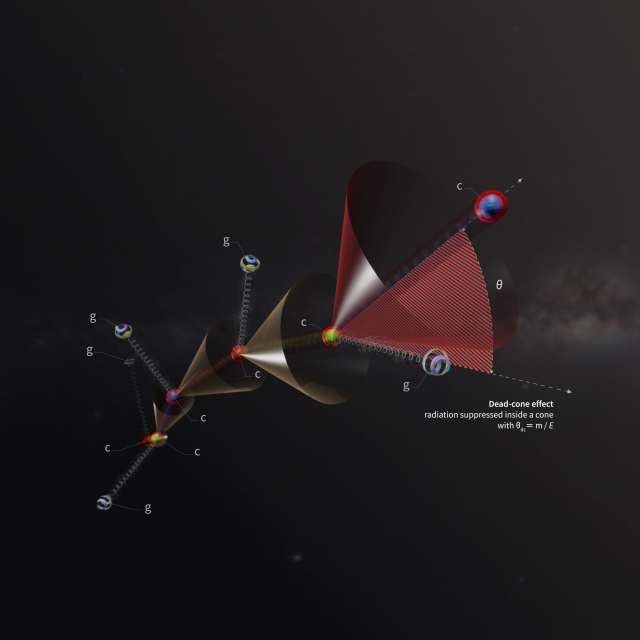Reviewed by Alex SmithMay 19 2022
The ALICE team at the Large Hadron Collider (LHC) has achieved the first direct detection of the dead-cone effect, a key characteristic of the strong force theory that binds quarks and gluons into protons, neutrons and eventually all atomic nuclei. The discovery, which was detailed in a study published in Nature, not only confirms the effect but also allows direct experimental access to the mass of a single charm quark before it is contained inside hadrons.
 A charm quark (c) in a parton shower loses energy by emitting radiation in the form of gluons (g). The shower displays a dead cone of suppressed radiation around the quark for angles smaller than the ratio of the quark’s mass (m) and energy (E). The energy decreases at each stage of the shower. Image Credit: CERN.
A charm quark (c) in a parton shower loses energy by emitting radiation in the form of gluons (g). The shower displays a dead cone of suppressed radiation around the quark for angles smaller than the ratio of the quark’s mass (m) and energy (E). The energy decreases at each stage of the shower. Image Credit: CERN.
It has been very challenging to observe the dead cone directly, but, by using three years’ worth of data from proton-proton collisions at the LHC and sophisticated data-analysis techniques, we have finally been able to uncover it.
Luciano Musa, Spokesperson, A Large Ion Collider Experiment
Particle collisions, such as those at the LHC, create quarks and gluons, which are referred to as partons. Partons go through a parton shower after they are created, in which they lose energy by producing radiation in the form of gluons, which in turn emit gluons. The radiation pattern of this shower is dependent on the mass of the gluon-emitting parton and shows a zone where gluon emission is inhibited around the direction of flight of the parton — the dead cone.
The dead cone has been indirectly observed in particle colliders, as predicted thirty years ago from the fundamental principles of the theory of the strong force. However, seeing it directly from the parton shower’s radiation pattern has proven difficult. The major reasons for this are that the dead cone might be filled with the particles that the emitting parton turns into and that determining the changing direction of the parton during the showering process is challenging.
The ALICE collaboration overcomes these obstacles by analyzing a large sample of proton-proton collisions at the LHC using cutting-edge analytic tools. The parton shower may be rolled back in time using these approaches, which are the signals left in the ALICE detector by a stream of particles.
The researchers were able to detect a jet formed by this sort of quark and trace back the quark’s whole history of gluon emissions by looking for jets that contained a particle carrying a charm quark. When the charm quark’s gluon-emission pattern was compared to that of gluons and virtually massless quarks, a dead cone was discovered in the charm quark’s pattern.
Since massless particles do not have equivalent dead cones, the result immediately reveals the mass of the charm quark.
Quark masses are fundamental quantities in particle physics, but they cannot be accessed and measured directly in experiments because, with the exception of the top quark, quarks are confined inside composite particles. Our successful technique to directly observe a parton shower’s dead cone may offer a way to measure quark masses.
Andrea Dainese, Physics Coordinator, A Large Ion Collider Experiment
Journal Reference:
ALICE Collaboration (2022) Direct observation of the dead-cone effect in quantum chromodynamics. Nature. doi.org/10.1038/s41586-022-04572-w.